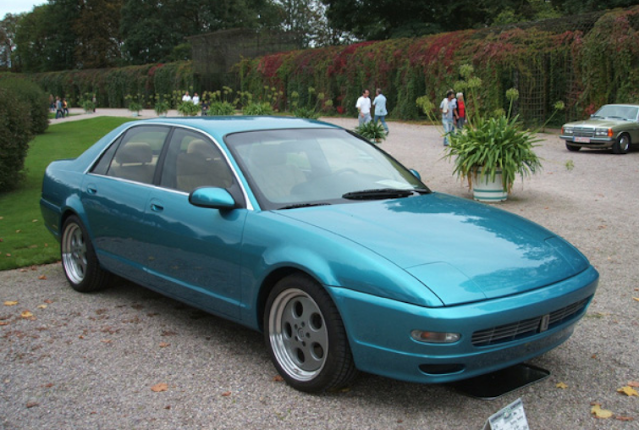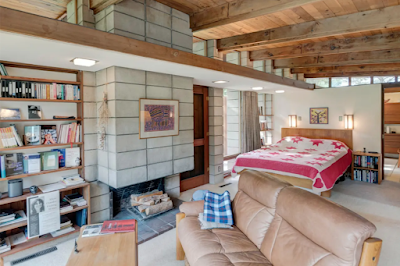We interrupt our regularly scheduled programming about mid-century cars and architecture (which may seem stunningly nonessential as the phrase "nuclear war" reappears in newscasts after a decent absence) to mention that World Central Kitchen is now serving refugees from the war in Ukraine as well as the ongoing chaos in Afghanistan. WCK has a perfect 100 score on Charity Navigator, translating into a 4-star rating. We wish the world were as safe a place for democracy as World Central Kitchen is for hungry refugees. We'll have some notes on architecture in Ukraine soon...
No, that's not a Bitter automobile in the above photo, but it began a series of developments that led Erich Bitter to offer a car under his name. The glassy, fastback Opel CD (Coupe Diplomat) show car from 1969 shows how designer Chuck Jordan ('63 Riviera, '67 Eldorado) could reduce form to essentials…or in this case, to less than essentials. One gained access to the car by lifting a canopy including the wraparound glazing, a trick GM's Larry Shinoda* had tried on the Corvair Monza GT* show car 7 years earlier. This would never work on a production car, especially at a time of tightening safety regulations. There was also the fact that although a Chevy V8 was planned, the CD show car was a non-running prototype. Never mind, though... GM Europe chief Bob Lutz thought the show car's form could be salvaged for a limited production car to attract customers to Opel's showrooms. Italian coach builder Pietro Frua* agreed, and soon enough Frua would build 2 prototypes of a luxury fastback with conventional doors and bumpers (well, a bit more bumpers than the show car), and real engines under their hoods...
Exactly a year after the CD show car's debut at the Frankfurt auto show, Frua's fastback reinterpretation attracted spectators and the automotive press at Frankfurt. Commissioned by Opel as production-ready (or at least production-friendly) prototypes, the Frua CDs seemed to be reinterpretations of Giorgetto Giugiaro's design for the Maserati Ghibli*, which had appeared on the Ghia* stand in Turin 4 years earlier. The low hood line featured a subtle blister to clear the 5.4 liter Chevy V8, and perhaps under the influence of GM's Chuck Jordan, Frua included the slanted vent slats from the show car behind the rear quarter windows. Both prototypes featured large hatches for luggage access, and the second one shown had a more substantial frame around the backlight. The Diplomat-based chassis featured disc brakes and a DeDion rear suspension. GM management, however, was not convinced to put the car into production.
Erich Bitter, however, saw the Frua CD's potential, and endeavored to get the car into production. Aiming at a true 2 + 2 configuration, a GM design team involving Dave Holls and Richard Ruzzin reworked the Frua design. The resulting Bitter CD, sometimes called the Opel Bitter CD because of GM's involvement, first appeared at the Frankfurt show in 1973, powered by a 5.4 liter (327 cu. in.) Chevy V8, its elegantly creased steel body sitting on a 105.5 inch wheelbase. Baur in Stuttgart, which had built the BMW 507 and was by 1973 building the BMW 2002 cabriolets, received the contract to build the bodywork for the new car.
The cabin was glassier than on the Frua prototypes, and the frameless rear hatch seemed not as well thought-out as the sturdier-looking one on the Frua CD, with the result that luggage would be on display. The front bumpers, however, were more substantial than on the Frua CD. Baur's bodywork gained a good reputation for workmanship, and the V8 provided lively enough performance despite the CD's 3,800 pound weight.
Metallic colors show off the form best, and the CD, which was produced from 1973 into 1979, sold 395 examples. Only 6 were produced in 1973, and 1974 was the CD's most successful year, with 99 units produced. After that, the oil crisis, along with the car's 58,500 DM price, slowed sales. Back in 1969, around the time GM was showing off that wild CD concept car, Frua had suggested something a bit more modest to compete with the Neue Klasse BMWs that were then costing Opel sales. Frua's Admiral Coupe B featured Opel's inline 6, a clean notchback profile, seating for 4, and even BMW's "Hoffmeister kink" at the C-pillar. Like the Frua CD coupes from the following year, however, it remained a prototype...
That earlier notchback coupe idea may have occurred to Bitter's product planners when it came time to replace the CD. Based upon the 6-cylinder Open Senator chassis, their new car made its debut a the 1980 Monaco GP, and because Baur was busy building the BMW M1, fledgling Italian coach builder OCRA built under 80 bodies before finish concerns led to Bitter moving the body contract to Maggiora. The SC's original shape had been sketched by Erich Bitter, but received detail attention and revision from Opel designers Henry Haga and Georges Gallion. Pininfarina performed wind tunnel testing on the result. The 3 liter car was later joined by a stroked 3.9 liter version of the Opel "cam-in-head" inline 6, and this improved the car's appeal in the US.
In 1981 a convertible joined the line, as well as a version of the coupe with all-wheel drive based upon the Ferguson system that had appeared in the Jensen FF. Only 22 convertibles would be built before the end of production in 1989; we're not sure how many Ferguson-equipped cars found customers.
Bitter also showed a stretched 4-door version of the SC, but only 5 of these sedans were built, perhaps because an effort to get Buick dealers to carry the Bitter as a competitor to BMW and Mercedes attracted only a few dealers. 488 of the SC series were built during the model run; the production effort had been hampered by the decline of independent coach builders, and maybe sales had been slowed by the perception that the Opel underpinnings were not in the same class as BMW or Mercedes. In the US, it cannot have helped that the proper pronunciation of Bitter is "beater"...
The SC series was discontinued after 1989, and Bitter collaborated industrial designer Tom Tjaarda* and Coventry's MGA Developments engineering team to produce a fiberglass prototype for the mid-engined Tasco supercar, which would have been powered by the V10 from Chrysler's Dodge Viper. This would have been the first engine sourced outside of GM for a Bitter product, but the Tasco, like the Opel CD show car that had kicked off the whole Bitter adventure over two decades earlier, remained a nonfunctional full-size model.
After the early Nineties supercar boom became a supercar bust, Erich Bitter commissioned Opel stylist Hideo Kadama to design new bodywork for the then-new Opel Omega B chassis. The prototype, again built by MGA in England, was first shown in 1995, and was revised with metallic aqua paint and a sleeker nose design for the '96 show circuit. Despite plans for a turbocharged, 24-valve 3 liter Opel V6, the car, now called the Bitter Berlina, never entered production.
Bitter's last effort at offering something exclusive and distinctive was not an unmixed success. The Vero, first shown in 2007 and produced in small numbers in 2008-09, abandoned the idea of a body design exclusive to Bitter, and instead adapted GM's Holden Commodore body shell (offered Stateside for a brief time before GM's Great Recession bankruptcy as the Pontiac G8) offered the small block GM V8 with a supercharger option bumping horsepower up to 550, but styling changes were largely limited to a hood with power bulge and a bland oblong grille with oversized "B" logo. The high price took care of exclusivity (only 10 cars were sold), but the Vero failed to offer anything like distinctiveness, and Bitter lacked the resources to tool up for something more special. The Vero was withdrawn after 2012, and after that Bitter cars offered its badge on production model Opels with luxury upgrades.
Footnotes: Cars and designers denoted with an asterisk were featured in these posts from our archives:
Larry Shinoda and the Corvair Monza GT (3-18-16)
Frua-bodied BMW and Glas (12-2-18)
Frua-bodied Monteverdi (7-9-19)
Ghia and the Maserati Ghibli (10-31-20)
Tom Tjaarda (4-30-20)
Photo Credits:
Top: General Motors
2nd: viathema.com
3rd: classiccarcatalogue.com
Top: General Motors
2nd: viathema.com
3rd: classiccarcatalogue.com
4th thru 6th: Bitter Cars
7th: Wikimedia
8th: carrozzieri-italiani.com
9th & 10th: bittercars.com
11th & 12th: bitter-parts.com
13th & 14th: bittercars.com
Bottom: Wikimedia








































































